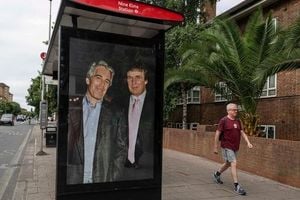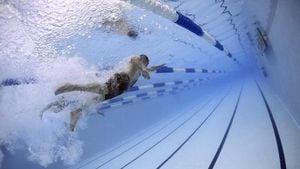NASA's current situation surrounding Boeing's Starliner spacecraft is anything but straightforward, and as the days pass, the uncertainty around the fate of two astronauts stuck aboard becomes clearer. It’s been over two months since Starliner set off on its inaugural crewed mission—a milestone for Boeing, which has faced numerous setbacks and delays. With astronauts Barry "Butch" Wilmore and Sunita "Suni" Williams still aboard the International Space Station (ISS), NASA is now weighing its options for getting them back home safely.
Initially, the mission was supposed to last around nine days, providing the crew with ample opportunity to conduct experiments and assist with routine operations at the ISS. However, technical problems started overshadowing the mission's success. Helium leaks and thruster failures began to emerge soon after launch, leading to continuous delays. The narrative of the Starliner mission quickly shifted from one of triumph to one of uncertainty, especially as reports began to circulate about the astronauts being "stranded"—a term NASA officials are eager to avoid.
It has now reached the point where agency officials are pondering whether to send the Starliner back empty or potentially utilize SpaceX's Crew Dragon for the return trip. According to several sources familiar with the situation, there is now more than a 50% chance the astronauts may end up leaving on Crew Dragon instead of Starliner, highlighting the growing lack of confidence from NASA’s side.
NASA spokesperson Josh Finch stated, "NASA is evaluating all options for the return of agency astronauts Butch Wilmore and Suni Williams from the International Space Station as safely as possible. No decisions have been made, and the agency will continue to provide updates on its planning." A stark shift from the initial confidence expressed about Starliner’s ability to return safely.
The issue with the Starliner spacecraft lies primarily with its thrusters. After arriving at the ISS, it became clear five of the spacecraft's thirty thrusters had failed during docking. This sparked deep concern among NASA’s engineers, who indicated they had yet to fully identify the root cause behind the failures. With weeks turning to months and no concrete answers, the specter of flying the spacecraft back safely now raises serious doubts.
Just last week, NASA’s Commercial Crew Program Control Board held discussions over the spacecraft’s readiness for return. The lack of consensus among board members underscores the challenges faced—ultimately delaying the decision-making process. The unease surrounding Starliner is palpable, especially with Boeing's already significant financial losses tallying up to $1.6 billion.
If discussions continue to trend toward the eventual use of Crew Dragon—originally seen as just a backup—the repercussions for Boeing could be dire. For the American aerospace giant, reliance on SpaceX could signal the end of its involvement with NASA's Commercial Crew Program. Such outcomes would not only damage Boeing's reputation but also strain relationships with NASA.
Yet, as scrutiny intensifies, it is important to note the wider perspective of such missions. Space exploration is fraught with challenges, and experimental missions are often destined to encounter unexpected issues. Experts highlight the historical precedent whereby early missions experienced similar hurdles, and without these learning opportunities, significant strides are rarely achieved. NASA emphasizes astronaut safety as its utmost priority and continues to insist on the importance of thorough testing and readiness.
Boeing claims they possess the "flight rationale" to believe Starliner is still capable of safely transporting the crew back home, but questions loom. Engineering officials are urging for continued investigations, seeking to pinpoint and test potential failures before any decision is made. Meanwhile, SpaceX is preparing contingencies for launching additional crew to bring Wilmore and Williams back.
The technical issues with the thrusters, alongside small helium leaks, have maintained much of the conversation around the mission, steering public perception toward negativity. Historically, media representations of spacecraft mishaps can amplify public anxiety, feeding narratives of being "lost" or "stranded." NASA officials are well aware of these dynamics and have been somewhat defensive, insisting all systems remain workable, and underscoring they have reliable means of emergency undocking should situations escalate.
On the ground, engineers have been working diligently to rectify the thruster issues through rigorous testing at NASA's White Sands facility. Luckily, 27 out of the 28 thrusters are performing normally. However, without clarity on the failures, NASA's leadership faces the tough decision of whether to trust Starliner enough to attempt its return flight.
While NASA balances the risks and the significance of recovering its astronauts safely, both space agencies continue to call attention to the operational challenges of human spaceflight. NASA's dilemma reveals the fragility of hope versus reality when it intertwines with vast sums of funding, expectations, and public scrutiny.
Should NASA decide to send the astronauts back on SpaceX's Crew Dragon platform, the agency may find itself under pressure to shift future contracts and reliance solely on SpaceX. This presents its challenges, drawing criticism from various quarters, and marking the dramatic end for another protracted saga of Boeing's Space endeavors.
Despite the challenges at hand, both Wilmore and Williams appear to maintain their spirits, recently expressing thanks for the extended stay on the ISS. They believe they remain well-equipped with supplies and are actively participating along with NASA’s team to resolve the issues plaguing Starliner.
Andy Thomas, managing director of the Australian space program and former astronaut, emphasizes the need for patience. "It’s critical for engineers and scientists to address these unplanned dilemmas, and there’s plenty of time for them to achieve critical data, particularly with systems aboard the ISS still operational and available for testing purposes." Space exploration has always involved complex machinations, which require fine-tuning even at the highest level. Every risk calculated—coupled with mitigative measures—ensures the utmost chances of success.
While confusion may swirl around the eventual outcome and method of return for Wilmore and Williams, lessons learned from this experience will frame the future of space exploration and mission protocol. By communicating effectively, managing public sentiment, and addressing engineering hurdles as they arise, the path forward for both NASA and Boeing may yet align toward eventual success.
The real question remains—which spacecraft will take the lead back to Earth?



